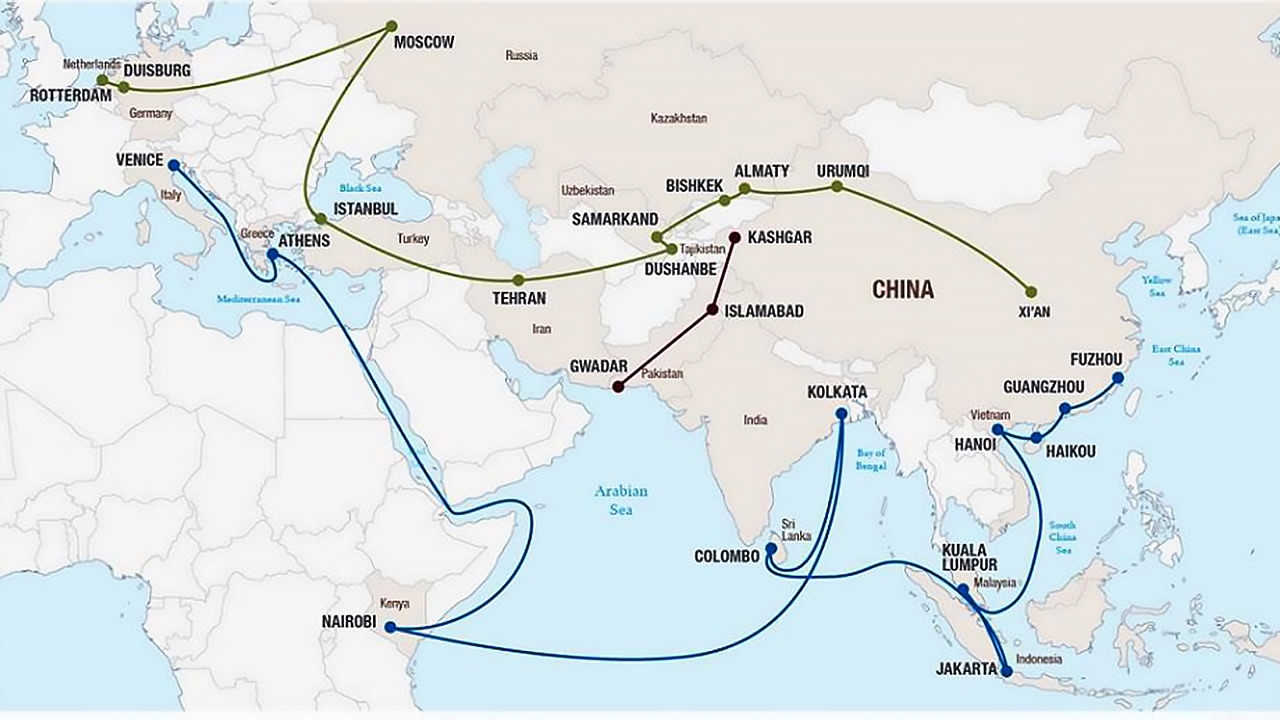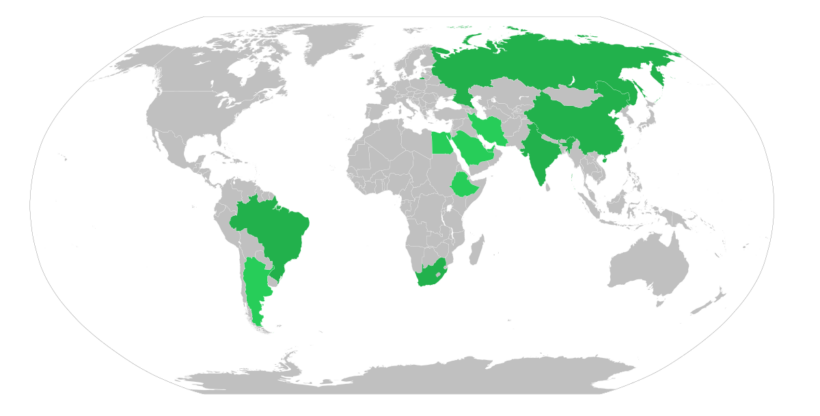At its recent XV Summit in Johannesburg, the economic bloc made up of Brazil, Russia, India, China and South Africa, announced the invitation to join as full members to six new countries: Argentina, Saudi Arabia, Egypt, United Arab Emirates, Ethiopia and Iran, which will become members as of 1 January 2024.
More than 40 countries had signalled their intention to join the group and 23 have already formally applied for membership. Founded in 2009 and enlarged to include South Africa in 2010, BRICS is now embarking on a phase of expansion that merits understanding in terms of its geopolitical, but also social and historical impact.
One of the questions that could indicate the direction of this association, which already groups 46% of the world’s population, is the criteria by which the new members have been chosen and the possible projection of new admissions.
As with any question, there are many sides to the issue, which is why it is worth remarking on it from different points of view.
The economic point of view
There is no doubt that among the priorities considered by the governments involved are the possibilities of strengthening the bloc’s economies, which together with the new members will account for around 36% of global GDP.
An essential point, declared and already implemented through various agreements, is the intention to dispense with the US currency in bilateral trade. The scope of this measure, together with the possibility under consideration of a trading currency made up of a basket of currencies called R5 (for the initials of the national denominations: real, rouble, rupee, renminbi (yuan) and rand), constitutes a serious challenge to the monetary hegemony of the dollar established after the Bretton Woods agreements.
The use of the dollar, which succeeded the pound sterling as the reference currency and since 1971 has abandoned gold backing, has allowed the US not only to save conversion costs and influence the world economy through the Federal Reserve’s interest rate setting, but also to afford and partially finance an immense deficit by issuing its own currency, two conditions that are usually imposed in reverse by the international lending agencies under its aegis on other countries.
In order to offer alternatives in this regard, the BRICS has created a new financing entity called the New Development Bank (NDB) based in Shanghai, with former Brazilian prime minister Dilma Rousseff as its president.
From the perspective of economic development interests, this strong enlargement of the bloc is primarily concerned with the possibility of securing access to energy sources on favourable terms. With the exception of Russia and to a lesser extent Brazil, the other BRICS countries depend on imports of non-renewable energies such as oil and gas, while Iran, Saudi Arabia and the Emirates are among the world’s main suppliers of crude oil. Argentina has grown as a producer of natural gas and shale, and is also a major food exporter and the main reservoir – along with Chile and Bolivia – of lithium, considered the new ‘white gold’.
On the other hand, as China is the largest economy in the group and one of the main proponents of BRICS enlargement, these steps should be analysed in parallel to the realisation of the infrastructure projects contained in the Belt and Road Initiative (BRI).
New infrastructure for old trails
This initiative, now in its tenth year since Xi Jinping announced it during an official visit to Kazakhstan, has so far attracted the interest of 155 countries, which in various forms have partnered or supported it. It is a gigantic infrastructure project that aims to compensate for connection deficits that hinder multilateral trade. Based on the ancient trade routes travelled overland by caravans along the Silk Road and recreating the maritime journey of Admiral Zeng He during the Ming dynasty, the BRI envisages the construction or improvement of ports, railways, roads, industrial enclaves, including water and energy supply sources and digital connectivity in many countries of the global South whose lack of them hampers their possibilities for the exchange of products and services.
If it was conceived by China to promote the multiplication of its commercial possibilities, to invest, to expand the economic activities of its own companies and also to enable the development of its economically depressed interior, this project radically modifies the map of global communication routes whose unmistakable stamp was set by the interests and needs of the former colonial powers.

Not least of these side effects are the need to maintain peace in the territories involved in order to be able to move forward smoothly with construction, but also the high level of new indebtedness that infrastructure investments always entail. On the other hand, the transfer of technology and training in its management also entails dependence on the installation of technological standards, which is evidenced by the West’s stiff resistance to the challenge to its previous supremacy in this field.
A crucial section of the maritime section of the project that connects Southeast Asia to the ports of Istanbul and Athens, gateways to Europe, is the Red Sea crossing, whose entry and exit points are Djibouti, where China maintains a military base, and the Egyptian-run Suez Canal. Ethiopia, another of the new BRICS invitees, which has lost its access to the sea since Eritrea’s independence, maintains its foreign trade through a Chinese-built railway line connecting its capital Addis Ababa with the port of Djibouti.
Geopolitical restructuring
Of fundamental importance in these times of global geopolitical map redrawing and an evident transition to multipolarity, it is worth noting that none of the new BRICS members belong to NATO, nor are they global partners, which perhaps explains why Turkey, also a stakeholder in the partnership and a rising economic pole, is not among the chosen ones, at least for the time being.
On the other hand, both Saudi Arabia and the United Arab Emirates are traditional US military allies in the Middle East, a leading role that has been eclipsed by China in its peace mediation efforts crowned by the recent agreement between the theocratic Saudi and Iranian governments. Both countries in turn have historic differences with Israel, considered a nuclear arsenal enclave of direct US influence in the region, which explains the search for balance.
Likewise, the fact that Ethiopia hosts the headquarters of the very active African Union, which claims and exercises key diplomatic influence in internal African affairs, adds to the understanding of its inclusion in BRICS+6.
Argentina, for its part, has been, together with Brazil under progressive governments, an important driving force behind sovereign regional integration bodies such as UNASUR and CELAC, which strengthens the multipolar sign and opposes the supposed exclusivity of US or Eurocentric dominance over Latin America. Together with Egypt, the founding member of the Non-Aligned Movement, South America has been a historic defender of a greater balance in global governance.
The enlargement of the BRICS is largely due to the urgent need to reformulate the functioning of international institutions such as the UN, which in practice have been co-opted by the weight that the United States of America continues to have in financing them.
Cultural diversity and globalisation
The imperial appropriation of recent centuries has imposed Western models, subjecting peoples to a relativisation or even denial of the contribution of their cultures to the human process.
The formation and expansion of a bloc of countries with diverse cultural roots such as the BRICS+6 is not only a reaction to neo-colonial continuity in economic and political terms, but also the upward movement of other models of thought and behaviour to a level of parity, thus strengthening diversity.
Ongoing globalisation, understood as a process towards which different cultures tend to converge without losing their Style of Life and identity [1], is very different from globalisation, a homogenising trend driven by imperialism, financial groups and international banking. From the perspective of globalisation, the emergence of nuclei such as BRICS+6 and associated institutions that allow formal interaction and act as a forum for dialogue and a pole of influence on a global scale is coherent.
Clearly, the new scope of this association, emerging from a global cultural reaction to attempts to standardise the world according to Western corporate desires, represents an important opening to different possibilities of relative autonomy and relations between peoples, without paternalistic mediations.
The shadows of BRICS
The authoritarian and strongly identitarian characteristics of the governments that make up the BRICS to date have escaped no one, characteristics that have served the global West to vilify them as undemocratic or undemocratic regimes.
Although Argentina has had a liberal-style democracy since 1983 and Ethiopia, whose democratisation process is very recent, the other new members do not seem to escape the pattern of strong rejection and repression of any kind of internal dissidence.
Although it is unwelcome to note, one probable thesis is that the emergence of strongly centralist governments with little tolerance for internal divergence – especially if it is supported from outside – is consubstantial with the need to put up a strong front against neo-colonial domination.
Even so, bracketing out the real obstacles that in these countries obstruct personal and collective freedom of choice and unacceptably oppress those who do not agree with the ruling ideologies, one might ask, not without a bitter taste in a humanist’s mouth, if these features of intolerance are not the reflection of a majority popular will.
Undoubtedly, the creeping transformations of recent years, systemic asphyxia and the lack of consultation with the people about their profound aspirations have a powerful influence, leading many to identify with reactionary attitudes or to affirm themselves in difference, as in the case of nationalism or religious fundamentalism. All the more so if they see that, beyond these traits, the socio-economic situation in some places, such as China, has improved for millions of people.
And as far as anti-democratic spirit is concerned, it is worth noting that none of the critical Western governments lag behind the BRICS, since the accumulation of power in the hands of large corporations and investment funds prevents the votes from being qualified as real elections of the people, making real systemic alternatives possible.
Certainly, this is a stage of humanity in which all violent behaviour needs to be overcome, even if these notions of a valid future encounter resistance in old habits.
In this sense, it is the populations themselves who will have to work on modifying its interior landscapes, which in turn will have a positive impact on the type and model of social organisation they freely choose.
The Universal Human Nation
A little-attended aspect, in this temporal realm of immediacy, is the broader historical point of view. From this perspective, BRICS+6, with the inclusion of its new members, is managing to bring together several of the main civilisations of human history.
The millennia-old accumulations of Egypt, China, India and the Persian world, the enormous contributions of the Slavic peoples and the Siberian steppe – in turn a concentration of the ways of life of many peoples, through the participation of Russia, Ethiopia and South Africa, two areas considered cradles of humanity, the articulation with the Arab nation and the contribution of the Latin American and Afro-American peoples and cultures form a mosaic, still incomplete, that reveals the intertwining and creative renewal of profound mythical sources.
In the declared framework of collaborators between governments and in the strengthening of relations between peoples that will result from common action, there is a growing germ that will go far beyond a multipolarism reactive to unipolar domination. It is the emergence of the first planetary civilisation in history, which, if it adopts a character of true horizontality, inclusion, emancipation and growing equality of opportunity, will become the foundation of a Universal Human Nation.
In this way, the Human Being will leave behind the violent prehistory, heading together to continue its path of liberation as a species.
[1] Globalisation. Dictionary of New Humanism. Silo (1996) Magenta Editions.






